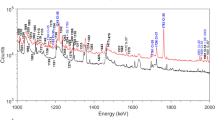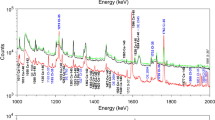Abstract
To observe the γ rays emitted from the low-lying isomeric state of 229Th (229mTh), we aim to dope fluoride crystals with its precursor 229Pa. In this study, we produced 229Pa by a 30 MeV proton bombardment on 232Th and developed a chemical separation method. The chemical yield of Pa was 93(4)%, and the physical production yield of 229Pa for the proton energy range of 29.0–30.1 MeV was measured to be 9.4(8) MBq/µAh, which was more than 10 times higher than those of 232,230,228,233Pa. These high chemical and production yields will allow us to prepare fluoride crystals having a sufficient amount of 229Pa for the observation of the γ rays of 229mTh.



Similar content being viewed by others
References
Seiferle B, von der Wense L, Bilous PV et al (2019) Energy of the 229Th nuclear clock transition. Nature 573:243–246
Sikorsky T, Geist J, Hengstler D et al (2020) Measurement of the 229Th isomer energy with a magnetic microcalorimeter. Phys Rev Lett 125:142503
Yamaguchi A, Muramatsu H, Hayashi T et al (2019) Energy of the 229Th nuclear clock isomer determined by absolute γ -ray energy difference. Phys Rev Lett 123:222501
Beck BR, Becker JA, Beiersdorfer P et al (2007) Energy splitting of the ground-state doublet in the nucleus 229Th. Phys Rev Lett 98:142501
Peik E, Tamm C (2003) Nuclear laser spectroscopy of the 3.5 eV transition in Th-229. Europhys Lett 61:181–186
Campbell CJ, Radnaev AG, Kuzmich A et al (2012) Single-ion nuclear clock for metrology at the 19th decimal place. Phys Rev Lett 108:120802
Peik E, Schumm T, Safronova MS et al (2021) Nuclear clocks for testing fundamental physics. Quantum Sci Technol 6:034002
Flambaum VV (2006) Enhanced effect of temporal variation of the fine structure constant and the strong interaction in 229Th. Phys Rev Lett 97:092502
von der Wense L, Seiferle B, Laatiaoui M et al (2016) Direct detection of the 229Th nuclear clock transition. Nature 533:47–51
Seiferle B, von der Wense L, Thirolf PG (2017) Lifetime measurement of the 229Th nuclear isomer. Phys Rev Lett 118:042501
Thielking J, Okhapkin MV, Głowacki P et al (2018) Laser spectroscopic characterization of the nuclear-clock isomer 229mTh. Nature 556:321–325
Tkalya EV, Schneider C, Jeet J, Hudson ER (2015) Radiative lifetime and energy of the low-energy isomeric level in 229Th. Phys Rev C 92:054324
Minkov N, Pálffy A (2017) Reduced transition probabilities for the gamma decay of the 7.8 eV isomer in 229Th. Phys Rev Lett 118:212501
Minkov N, Pálffy A (2019) Theoretical predictions for the magnetic dipole moment of 229mTh. Phys Rev Lett 122:162502
Minkov N, Pálffy A (2021) 229mTh isomer from a nuclear model perspective. Phys Rev C 103:014313
Shigekawa Y, Yamaguchi A, Suzuki K et al (2021) Estimation of radiative half-life of 229mTh by half-life measurement of other nuclear excited states in 229Th. Phys Rev C 104:024306
Dessovic P, Mohn P, Jackson RA et al (2014) 229Thorium-doped calcium fluoride for nuclear laser spectroscopy. J Phys Condens Matter 26:105402
Ellis JK, Wen X-D, Martin RL (2014) Investigation of thorium salts as candidate materials for direct observation of the 229mTh nuclear transition. Inorg Chem 53:6769–6774
Jeet J, Schneider C, Sullivan ST et al (2015) Results of a direct search using synchrotron radiation for the low-energy 229Th nuclear isomeric transition. Phys Rev Lett 114:253001
Stellmer S, Schreitl M, Schumm T (2015) Radioluminescence and photoluminescence of Th:CaF2 crystals. Sci Rep 5:15580
Beeks K, Sikorsky T, Rosecker V et al (2023) Growth and characterization of thorium-doped calcium fluoride single crystals. Sci Rep 13:3897
Stellmer S, Kazakov G, Schreitl M et al (2018) Attempt to optically excite the nuclear isomer in 229Th. Phys Rev A 97:062506
Masuda T, Yoshimi A, Fujieda A et al (2019) X-ray pumping of the 229Th nuclear clock isomer. Nature 573:238–242
Zimmermann K (2010) Experiments towards optical nuclear spectroscopy with thorium-229. PhD thesis, Univ Hannover, Germany
Verlinde M, Kraemer S, Moens J et al (2019) Alternative approach to populate and study the 229Th nuclear clock isomer. Phys Rev C 100:024315
Kraemer S, Moens J, Athanasakis-Kaklamanakis M et al (2023) Observation of the radiative decay of the 229Th nuclear clock isomer. Nature 617:706–710
Browne E, Tuli JK (2008) Nuclear data sheets for A = 229. Nucl Data Sheets 109:2657–2724
Daimon M, Masumura A (2002) High-accuracy measurements of the refractive index and its temperature coefficient of calcium fluoride in a wide wavelength range from 138 to 2326 nm. Appl Opt 41:5275
Shigekawa Y, Wang Y, Yin X et al (2022) Development of a photon measurement apparatus for observing the radiative decay of 229mTh produced from 229Pa. RIKEN Accel Prog Rep 55:124
Pickett DA, Murrell MT, Williams RW (1994) Determination of femtogram quantities of protactinium in geologic samples by thermal ionization mass spectrometry. Anal Chem 66:1044–1049
Shen C-C, Cheng H, Edwards RL et al (2003) Measurement of attogram quantities of 231Pa in dissolved and particulate fractions of seawater by isotope dilution thermal ionization mass spectroscopy. Anal Chem 75:1075–1079
Griswold JR, Jost CU, Stracener DW et al (2018) Production of 229Th for medical applications: excitation functions of low-energy protons on 232Th targets. Phys Rev C 98:044607
Watanabe T, Fujimaki M, Fukunishi N et al (2014) Beam energy and longitudinal beam profile measurement system at RIBF. In: Proceedings of the 5th Int Particle Accelerator Conf (IPAC2014) pp 3566–3568
Ziegler JF, Biersack JP, Ziegler MD (2013) SRIM: the stopping and range of ions in matter
Keller C (1966) The chemistry of protactinium. Angew Chem Int Ed Engl 5:23–35
Radchenko V, Engle JW, Wilson JJ et al (2016) Formation cross-sections and chromatographic separation of protactinium isotopes formed in proton-irradiated thorium metal. Radiochim Acta 104:291–304
Trubert D, Guzman FM, Naour CL et al (1998) Behaviour of Zr, Hf, Nb, Ta and Pa on macroporous anion exchanger in chloride-fluoride media. Anal Chim Acta 374:149
Faris JP, Buchanan RF (1964) Anion exchange characteristics of the elements in nitric acid medium. Anal Chem 36:1157–1158
Faris J (1978) Separation of metal ions by anion exchange in mixtures of hydrochloric acid and hydrofluoric acid. ANL-78-78.
Kmak KN, Shaughnessy DA, Vujic J (2021) Measurement of the 230Th(p, 2n) 229Pa and 230Th(p, 3n) 228Pa reaction cross sections from 14.1 to 16.9 MeV. Phys Rev C 103:034610
Steyn GF, Motetshwane MA, Szelecsényi F, Brümmer JW (2021) Pairing of thorium with selected primary target materials in tandem configurations: co-production of 225Ac/213Bi and 230U/226Th generators with a 70 MeV H- cyclotron. Appl Radiat Isot 168:109514
Abusaleem K (2014) Nuclear data sheets for A = 228. Nucl Data Sheets 116:163–262
Koning AJ, Rochman D, Sublet J-Ch et al (2019) TENDL: complete nuclear data library for innovative nuclear science and technology. Nucl Data Sheets 155:1–55
National Nuclear Data Center, Nuclear structure and decay data on-line library, Nudat 3.0. https://www.nndc.bnl.gov/nudat3/
Shigekawa Y, Haba H (2022) Surface ionization of protactinium toward implanting 229Pa into a CaF2 crystal. RIKEN Accel Prog Rep 55:126
Acknowledgements
This experiment was performed at RI Beam Factory operated by RIKEN Nishina Center and CNS, University of Tokyo. This work was supported by JSPS KAKENHI Grant Number 19K23445.
Author information
Authors and Affiliations
Corresponding author
Ethics declarations
Conflict of interest
The authors declare that there is no conflict of interest.
Additional information
Publisher’s Note
Springer Nature remains neutral with regard to jurisdictional claims in published maps and institutional affiliations.
Rights and permissions
Springer Nature or its licensor (e.g. a society or other partner) holds exclusive rights to this article under a publishing agreement with the author(s) or other rightsholder(s); author self-archiving of the accepted manuscript version of this article is solely governed by the terms of such publishing agreement and applicable law.
About this article
Cite this article
Shigekawa, Y., Yin, X., Nambu, A. et al. Production and chemical separation of 229Pa toward observation of γ rays of 229mTh. J Radioanal Nucl Chem 333, 1479–1486 (2024). https://doi.org/10.1007/s10967-023-09069-y
Received:
Accepted:
Published:
Issue Date:
DOI: https://doi.org/10.1007/s10967-023-09069-y




